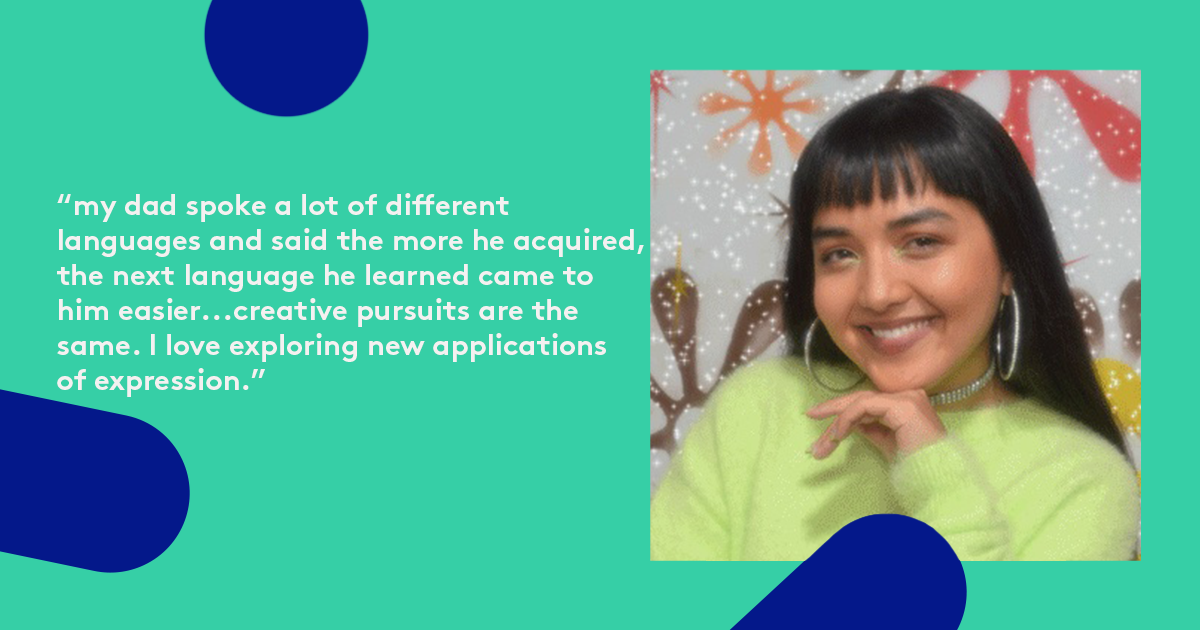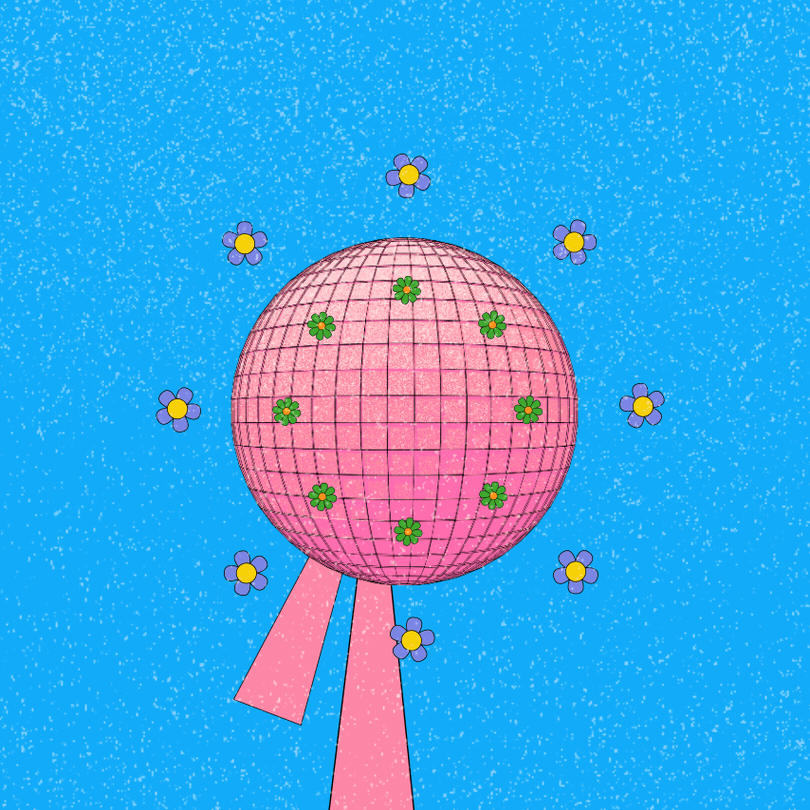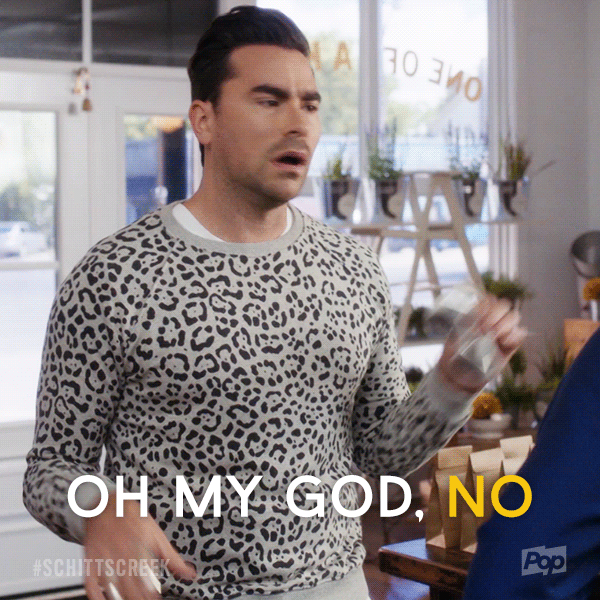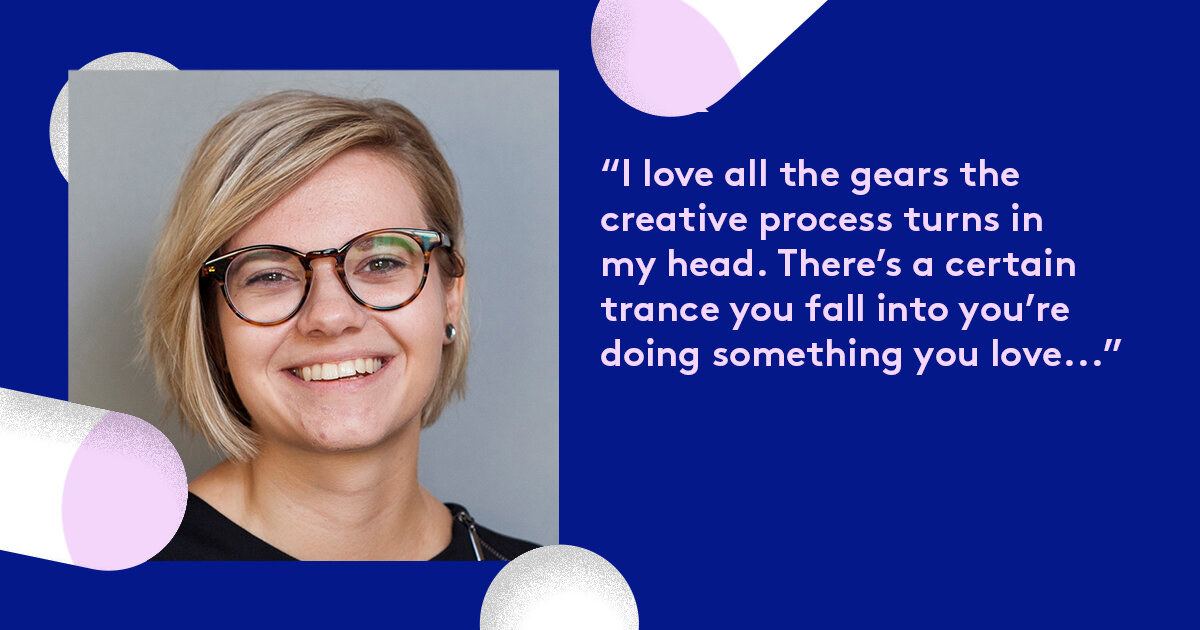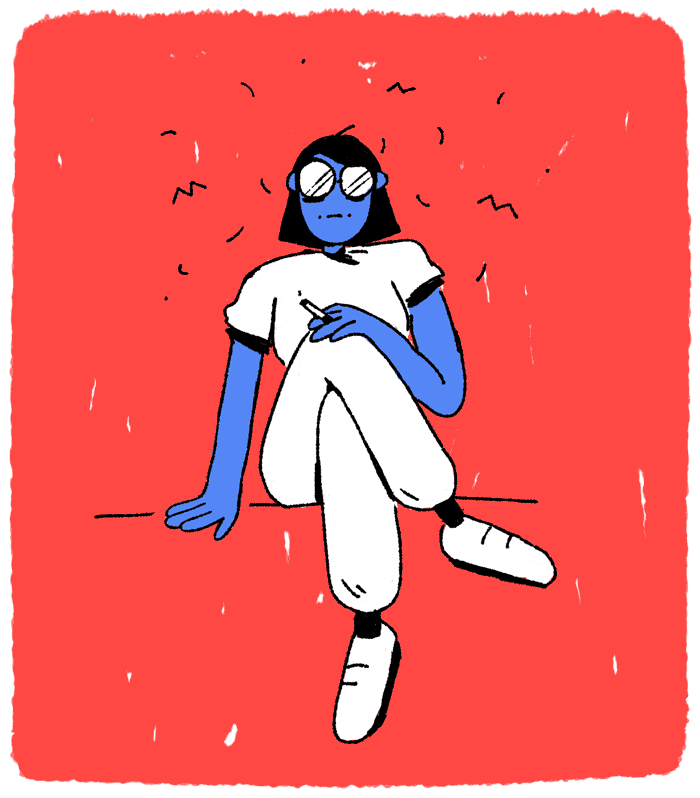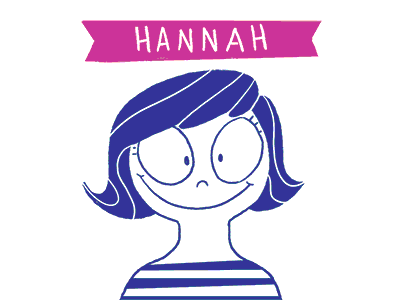Takeover Tuesday with Sazan Pasori
Q&A with Sazan Pasori, an Animator, Designer, and Art Director based in Los Angeles.
Q&A with Sazan Pasori
Read time: 5min
Madison Caprara:
Hi, Sazan! Why don’t you give us a little introduction to yourself to start us off?
Sazan Pasori:
My name is Sazan (pronounced SUH-zan). I’m an Art Director and Motion Designer based in Los Angeles. I’m a lover of color and art that doesn’t take itself too seriously. I feel lucky to get to make fun little animations for a job, but I think even if I didn’t work in this industry, I would be pulled to create things. It really feels like a compulsion!
Madison Caprara:
What education route did you end up going down, and how do you feel that experience has helped you develop as a creative?
Sazan Pasori:
I went to college at the University of San Francisco, where I studied creative writing and graphic design. I didn’t really know what I wanted out of a career, but I would lose track of time writing and designing, and figured if I could combine the two somehow down the line, that would be a pretty cool career. I eventually landed on motion design/animation/art direction after moonlighting in visual merchandising, copywriting, and creative strategy. Some motion designers I had met also encouraged me to try it out. It felt like an “a-ha” moment. I quickly dove into YouTube tutorials and animation boot camps and got totally hooked. The rest is herstory!
Madison Caprara:
Now, a lot of art directors have pretty diverse backgrounds--such as yourself! What do you think are some key qualities or experiences that good AD’s have in common?
Sazan Pasori:
In my opinion, the best art directors have a combination of instinct and discipline. Generally, they’re creative people with “an eye,” but the best ones spend lots of time researching references, developing their craft, and continually evolving/improving their output. I aspire to be this kind of art director!
Madison Caprara:
Having to wear so many hats, do you have a favorite niche or role to work within?
Sazan Pasori:
I’m a believer in the oneness of creative pursuits...I guess what I’m trying to say is that I don’t have a favorite!
Lately, I’ve really enjoyed directing and making music! Growing up, my dad spoke a lot of different languages and said the more he acquired, the next language he learned came to him easier. I feel creative pursuits are the same. I love exploring new applications of expression.
Madison Caprara:
What’s it like to work for GIPHY? Give us the lowdown.
Sazan Pasori:
Working at GIPHY is like working at a wacky animated online library. I’m just one of the librarians.
Madison Caprara:
So fun! What is it about GIFs that make them so popular in everyday conversation, in your opinion?
Sazan Pasori:
The English language can sometimes fail to capture subtle moments and feelings. GIFs give you the satisfaction of specificity, physical expression, and relatability.
Madison Caprara:
What has been your favorite, or most memorable, project to date?
Jonas Brothers x GIPHY
Sazan Pasori:
This year I co-directed an animated short with my GIPHY colleague, Tianna Harvey, titled, Blobs in Space. The one-minute animation is a 2D/3D ballad turned disco bop about connection in the time of COVID-19. Check it out! It’s a hilarious and tragic little journey.
Madison Caprara:
Pivoting back to your role, what are some of the most unexpected challenges or frustrations you have had to deal with?
Sazan Pasori:
I think artists of all kinds feel an immense amount of pressure to constantly produce new work (I know I struggle with this). I’ve definitely suffered from burnout and am working towards a life where rest and recovery are critical parts of my creative process.
Madison Caprara:
Who are some of your biggest artistic influences?
Sazan Pasori:
Everybody who knows me knows I’m a supa dupa mega Missy Elliott stan. She is my idol! Her multi-hyphenate background and out-of-the-box approach still feel like the future.
Madison Caprara:
What are some of your top career goals? Are there any you have already achieved?
Sazan Pasori:
In my opinion “career goals,” are better framed as “creative pursuits,” as I mentioned previously. A career is so tied up in your livelihood—how can my job pay my bills, you know? When you try to tie your livelihood and identity to a career...and your goals! WHEW! Now you’re simply asking too much from your career.
As far as my “career goals” go though, I’ve made it! I get to make things and get paid enough to live my life. In the future, I’d love to make longer-form content and experiment more with analog techniques.
Madison Caprara:
That’s a really healthy way to look at your career. We do have a tendency to make our job titles and identities synonymous.
Do you have any advice for aspiring art directors?
Behance: Sazan Pasori | Angel Off-Duty
Sazan Pasori:
My advice would be to just start making things! When I first started out as a designer, I was terrified to even put pen to paper. Sure, a lot of the stuff I made at first sucked, but you have to push through that initial stage until you start making things that look cool.
Madison Caprara:
Great advice!
Now, as we start to wrap it up, is there anything in particular that you would like to end this interview on?
Sazan Pasori:
A quote that has brought me immense comfort as a creative and as a person is: “Whatever it is you’re seeking, won’t come in the form you’re expecting.”
The quote is by fiction author, Haruki Murakami, and reminds me to ease up a little and let things play out. White knuckling a project, your career, or life won’t change it’s outcome.
Takeover Tuesday with Phoenix Owens
Q&A with Phoenix Owens, an LA-based Motion Designer, Illustrator, and self-dubbed GIF Master.
Q&A with Phoenix Owens
Read time: 10min
Madison Caprara:
Hey, Phoenix! Why don’t you give us a little introduction to yourself and your work? How would you describe your style?
Phoenix Owens:
Hi, y'all! Thank you so much for having me. My name is Phoenix Owens, I’m an Illustrator, Designer, and occasional Animator. I am originally from a small town in Georgia called Kennesaw but now reside in Los Angeles. I exchanged the yellow pollen for the sunny skies and am loving it!
I graduated from Otis College of Art and Design in 2016, majoring in Digital Media with a focus in Motion Graphics. Now post-graduation, I’ve been working in the design industry for the past five years. I would describe my style as a happy accident that came about by a lot of trial and error. Within my pieces, you will find elongated and curvy body proportions which is a common characteristic that is found in Black excellence, beauty, and acceptance. Additionally, I showcase powerful women. This is a nod to being raised by two remarkable women: my Japanese grandmother, and biracial mother.
Madison Caprara:
I definitely noticed those themes in your personal, illustrative work. It’s great to get a little background on that!
Having graduated from Otis College of Art and Design, what are your thoughts on pursuing a formal education within this industry? Necessary or not?
Phoenix Owens:
I think each person has to answer that question for themselves. Personally, going to art school was necessary to awaken my creative potential. I liken it to those martial arts movies like The 36th Chamber of Shaolin where the protagonist enters the Shaolin training facility to become a better martial artist; I had to do that for myself. I knew if I tried it out on my own, I would find an excuse to give up.
Going to Otis helped me develop the artistic discipline necessary to become successful. Art school is expensive, but it was a worthwhile investment for me. Now I know people who didn’t attend college and are doing great in the industry. My advice is to determine your path and be devoted to your journey no matter what others say.
Madison Caprara:
Other than gaining discipline, was there anything you believe you would not have gained on your own if you had chosen to forgo Otis?
Phoenix Owens:
In addition, I needed to build a foundation of art knowledge. Knowledge is definitely power! At the time, I had an understanding and working knowledge of different types of art styles but I didn’t have the language to understand why they worked. By attending Otis, I was pushed to study art history, fundamentals, and current styles. Not gonna lie, I hated doing all of that homework but I’ve experienced the value of knowledge gained during projects that I’ve worked on. Even though I have graduated, I am an avid learner and I feel once you stop learning you die creatively.
Madison Caprara:
So, you graduated college and landed a full-time gig with PopTV. How did that come about? What kind of work were you doing?
Phoenix Owens:
Wow! You’re really taking me down memory lane with this question. The time of my graduation was very stressful. While I was in college, I was working three on-campus jobs to pay rent and other expenses. Upon graduation, I didn’t have those jobs anymore. To make rent I had to sell some of my possessions. It was a ‘do or move’ situation, meaning if I couldn’t find a job then I would have to move back to Georgia with my family. I decided that my current job was to apply for work every single day, morning to evening. I came upon the PopTV opening while looking on a job board. It was listed as a Motion Designer position.
I applied at 9:00 am and got an immediate response asking for a meeting that same day. Nervously, I took the interview and thinking back on it, I must have looked like a hot mess. I had straight red hair at the time and wore a dress-up shirt and nice slacks to the interview. Never again. So the meeting was with the Creative Services Manager and the On-Air Design Director. Long story short, they hated my portfolio and critiqued the heck out of it. I left the meeting feeling like an amateur and was 100% positive that I wouldn’t get the job. I went back to my apartment, calmed my nerves with my Buddhist practice, and made the decision that I wouldn’t give up. PopTV was where I was meant to be.
Phoenix Owens:
I started studying different broadcast design effects as well as the type of on-air spots PopTV would use. That night I created a 10-second piece that highlighted one of their shows and sent it to the manager and director the next morning with my thank you email. Three hours later I got a call from the manager who offered me a position, but it wasn’t the position I had originally applied for. It was an opportunity to support the Social Media Department.
While working at PopTV, I learned how an in-house design team functions for a network. I tell people I mostly made GIFs and dubbed myself as a GIF Master. I would have to find spots in each episode to GIF out for live-tweeting. At times, the producers would watch the show and give me timecodes to reference or I would watch the episode myself. This is how I became a fan of Schitt’s Creek. I had to watch the episodes to find moments, naturally, I started liking it. Now, I didn’t only do GIFs (which at times it seemed like I did) but I also got to create other content for social media, like tune-in cards and video memes. Towards the end of my time at PopTV, I became the go-to person for on-air, tune-in messaging. So if you ever watched the station during that time, you saw the graphics I animated telling you what show was coming up next.
Madison Caprara:
Wow, mad props to you for taking that extra initiative and going after what you wanted!
What do you think it is about GIFs that make them such an interesting medium?
Phoenix Owens:
I see them as another language or form of expression. One of my favorite shows is The Office, I especially love seeing so many GIFs made featuring Michael Scott. While I know exactly which episode a Michael Scott GIF comes from, the way it could be used in conversation is an entirely different language. The use of an animated picture takes personal expression to another level of understanding and interpretation when discussing dialogues, plots, and themes. I find them quite fun and enjoy seeing the ones I created out in the wild.
Madison Caprara:
Even more importantly, is it pronounced ‘JIF’ or ‘GIF’?
Phoenix Owens:
JIF is a peanut butter brand that can be bought at your local grocery store. It makes a great snack (pro tip) when working late nights on a project or playing video games. So from this GIF Master, it is pronounced ‘GIF’!
Madison Caprara:
You’ve heard it here from the GIF Master himself. Thank you for settling that debate.
You have some pretty top-notch projects within your portfolio. I know you spoke a little on it before, but I’m definitely fangirling over the Schitt’s Creek work. What has been your favorite project to date?
Phoenix Owens:
Not listed on my portfolio site, but my favorite project is a Juneteenth one that I worked on with Creative Mammals. The client happened to be with Disney, who is on my dream client list! So when Creative Mammals approached me to jump on board I didn’t hesitate to say yes. I was designing and illustrating a Juneteenth piece during a time when it had just become a national holiday. I am proud to have been part of such a historic work.
Madison Caprara:
What about the most challenging project you’ve taken on?
Phoenix Owens:
Honestly, I can’t pick one project that is challenging. I feel each project that I am tasked to do poses its own individual challenges. It isn’t so much about knowing how to do something as it is about me facing my inner doubt. My Imposter Syndrome that surfaces every time I start working. Thoughts of: “They made a mistake by hiring me” or “I’m not qualified to be in this position” race around my mind and are quite frustrating. I keep this Buddhist quote close to my heart “Become the master of your mind rather than let your mind master you.” I’m learning to trust myself and my abilities more as I continue to grow as an artist. There is always a solution to any art project.
Madison Caprara:
I have yet to meet a single person, creative or not, who hasn’t experienced Imposter Syndrome to some degree. That in itself is a little comforting. We’re all just out here doing our best.
Now, you’ve pivoted over to freelance work, correct? Have there been any significant hurdles with that career change?
Phoenix Owens:
Becoming a freelancer wasn’t by design. I was working at PopTV when the company became a part of the ViacomCBS merger, and I was one of the people who got laid off in February 2020. I was terrified. In the midst of the layoff, we saw the whole world shut down because of the COVID-pandemic in early March of that year. I was directionless for months as I watched how things were unfolding in the world. Like a lot of people, the unknown was scary for me but I decided to make good use of my time. I started drawing more and taking online classes to expand my knowledge. I saw my time spent learning as training for a battle in the future. I did struggle within my studies, as I have a habit of comparing my work to others. I’m sure a lot of people know this is the fastest way to discourage yourself.
The biggest challenge of starting off as a freelancer for me was that I didn’t see people who looked like me in the industry. When I looked at the landscape of the motion design industry, I didn’t see any Black artists. I felt I was at a disadvantage and that I wouldn’t be hired because it isn’t the norm to see a Black person in the motion design industry. With the tragic passing of George Floyd, reigniting the worldwide Black Lives Matter movement, everything changed for me. It was like an emotional alarm clock that woke up the world. Every industry had to look at itself, and what became apparent was the lack of BIPOC. Because of that, I feel a lot of opportunities are now being given to BIPOC. I even had a studio specifically say they were focused on hiring a Black designer because of their lack of diversity. Personally, it felt disingenuous but I guess at least they were being honest. Now that I have been successfully freelancing for one year, I hope I’m known for my hard work and skillset and not as a diversity hire.
Madison Caprara:
It’s sad that it took a tragic, completely avoidable event to channel that lens inward. Something that now needs to be the focus of these companies, is making sure that they’re not just making these diversity hires for the sake of reaching a certain demographic percentage. The solution requires more depth. Companies need to prioritize educating themselves on this country’s long-standing history of systematic racism as a whole. It’s not enough to WANT to create change, you need to truly understand WHY it’s necessary in the first place.
Pivoting back to your freelance experience, I recently read a study on how out of every professional industry, creative freelancers were hit the hardest by this pandemic. I’ve gotten some pretty mixed reviews on that statement. Some are saying that the emphasis on remote work has significantly opened their client pool. Does this ring true for you?
Phoenix Owens:
I started freelancing during the pandemic. Because of that, I don’t have the same experiences as some of my friends who had to go in-person to studios before everything went remote. For me, I am enjoying this remote working life. I feel it is such a great way to work with companies all around the nation and the world. I never would have believed that I could work for a company in New York or Atlanta while still living in Los Angeles.
Madison Caprara:
I am also a member of Team Remote.
Where do you go for inspiration?
Phoenix Owens:
I don’t have a set place for inspiration, but I know that it comes to me once I stop working and step away from the computer. At times, it feels like I'm always attached to my computer screen. Inspiration seems to strike me at weird moments. I don’t tend to look for it. Listening to music or going to music festivals, traveling, going to museums, looking at fashion trends, talking to people, or watching anime or shows are my go-to places. When I allow myself to relax and immerse myself in a moment, I tend to be more open to creative thought. A lot of times it is a question of “What if” and I would take a picture, write down the idea, or do a quick sketch on my phone. By creating a log of my inspiration I have a library to go back to when I need it the most.
Madison Caprara:
Is there anything special we can look forward to seeing from you?
Phoenix Owens:
I have an ongoing list of creative goals. A few things I will do by the end of the year are learning 2D animation, coming up with a new art style, and starting to sell prints and merch of my work. I find that having goals keeps me excited and focused as an artist. I never want to become stagnant as a creator.
Madison Caprara:
Well, I really enjoyed this talk, Phoenix. Wrapping up, do you have a final piece of advice or closing point you’d like to end on?
Phoenix Owens:
I want everyone to know that it’s okay to be scared, but don’t let that fear hinder you from going after what makes you happy. For me, I don’t want to look back and have regrets that I didn’t do something because it wasn’t worth the challenge. Pursuing your passion and doing what you love isn’t easy. It will challenge you mentally and physically, but those pains aren’t forever. When they pass, you’ll look back on them as needed obstacles for growth.
Be sure to do things outside of work. It helps to have a balanced lifestyle to refuel you creatively. Whether it is playing video games or hiking, taking time away from the screen is therapeutic.
Phoenix Owens:
Oh and one last thing, remember to drink water!
Takeover Tuesday with Lana Simanenkova
Another Takeover Tuesday for your viewing pleasure. This week we have chat with Lana Simanenkova, a freelance animator and illustrator. Originally from Estonia, she is currently based in London, UK.
Q&A with Lana Simanenkova
Read time: 5 min
Why did you choose your profession? How did you go about starting out?
I had not done very well in school, so I thought that getting a degree in media would be a good idea. I applied to various courses and got accepted into an animation program. Lucky for me, I ended up loving animation and motion graphics. I have been doing it professionally for over seven years now. I started out as an intern making animated ads full-time, then grew that role into a senior creative position which I stayed in for over five years. About a year and a half ago, I left to pursue a freelance career.
What does Women’s History Month mean to you? Why is it personally significant in 2021, particularly?
It's a great way to highlight the amazing talent that often goes underappreciated. It’s also an opportunity to not let anyone forget that there is still much work to be done in terms of gender equality, in the workplace especially.
What do you love most about what you do? What would you change?
I love all the gears the creative process turns in my head. There's a certain trance you fall into when you do something you love and the time flies. That's the most enjoyable feeling for me. As for what I would change, I always try new animation tools with the hope that one day there will be a viable alternative to some of the Adobe products to create more options in the 2D vector field.
“none of my mentors were women, so I had to navigate the male-heavy animation industry by trial and error.”
Tell me about a woman you look up to and why.
I'm a proper big fan of Joanna Quinn. I discovered her work through a film festival in London and even met her once. She’s as badass as her work is; so cheeky and full of life. The linework and the dynamic movement are something I've not seen anywhere else, so I got completely bewitched. She's amazing and I always look forward to her new works.
What’s the best career (or life) advice you have ever received?
Never assume the client knows something already. Especially if they are new to animation. In that case, the more hand-holding and explaining you do, the better the whole process can be. That way you both know what you’re getting from each other.
Do you have any advice for young women first starting out in this industry?
Try and connect with other women in the industry or potentially seek out a mentorship with one. None of my mentors were women, so I had to navigate the male-heavy animation industry by trial and error; when it comes to meetings, asserting my opinion, noticing subtle sexism, etc. I think finding a role model you can reach out to makes a huge difference.
Do you currently prioritize your work-life balance? If so, how?
I've actually gone freelance a bit more than a year ago exactly for this reason. The commute to London, stagnant wages, and some company re-structuring didn’t mesh with what I wanted for my career at that time. Since going freelance I am more in control of the jobs I take on and the image I want to project to potential clients.
“I love all the gears the creative process turns in my head. There's a certain trance you fall into when you do something you love and the time flies.”
What barriers are women still facing in the industry? How do you think they can go about breaking them down?
I think I struggle being taken seriously in meetings. Some studios are mostly still very male-heavy when it comes to animation. Getting my ideas and feedback adequately heard can be a struggle, and I'm sure other women would have had a similar feeling or experience. This kind of thing needs to be changed by hiring more women in leadership positions along with current studio owners taking the time to speak with their staff about topics such as these while making it a safe place to do so.
“never assume the client knows something already. Especially if they are new to animation. In that case, the more hand-holding and explaining you do, the better the whole process can be. That way you both know what you’re getting from each other.”
Where do you go for inspiration?
I check the website, Short of the Week (https://www.shortoftheweek.com/), almost daily as it's a great collection of short films. Both animation and live-action. The site really gets my storytelling juices flowing.
Also, there are some very well curated blogs on Vimeo such as Eye Explosions (https://vimeo.com/channels/eyeexplosions) that are dedicated to motion design. Here, I try to keep my eye on the latest and hottest ads/short films. I also keep a Pinterest page where I have a collection of inspirational images; from interior design all the way to 3D character designs and such. It’s a great place to get lost for a couple of hours, great for references.
Do you have any closing advice, points, or statements you would like to make?
I'd like to highlight some of the women and non-binary-focused groups that are doing a great job at building a community that helps people in the design and motion graphic fields. There are some amazing places to talk about art, work, the business of it all, and much more. Panimation and SheDrewThat both have a Facebook and Slack group that are free to join, I can't recommend them enough.
Panimation - https://www.instagram.com/panimation.tv/?hl=en
SheDrewThat - https://www.instagram.com/shedrewthat/?hl=en
Takeover Tuesday with Hannah Churn
Introducing our new series…Takeover Tuesday; an opportunity to speak with outside creatives to gain their unique insight on industry going-ons, current events, and their own personal experiences. We’re kicking off with Hannah Churn! Hannah is an art director and animator for Duke & The Duck.
Q&A with Hannah Churn
Read time: 5 min
Why did you choose your profession? How did you go about starting out?
My mom had access to Flash (then Macromedia!) at her job when I was a kid, she told me you could make cartoons with it and it blew my ten-year-old brain. I started off in the industry doing 3D character animation. I wanted to do 2D, but my drawing skills at the time weren’t that great and the motion graphics that we know today hadn’t really taken off. With practice over time, my drawing skills improved, and I soon found myself tooling around in After Effects.
What does Women’s History Month mean to you? Why is it personally significant in 2021, particularly?
Women’s History Month, to me, means giving the space and creating platforms for women to share their stories; making them more accessible, and having their voices heard. When I transitioned from 3D character animation to motion graphics, my first task was watching all the AE tutorials I could find. The more I watched, the more I realized there were zero women making them. It was so hard - then - to find other women who were in the motion graphics field. I ended up finding a few from a motion graphics blog that highlighted ten women in the field at the time, giving them a platform to amplify their voices.
What do you love most about what you do? What would you change?
I love evoking emotion from the animations I work on. If I can get someone to laugh out loud or feel the feels, it means I’ve been able to visually communicate a story well.
Honestly, I’m not sure if there are any big things I would change, I really enjoy what I do. If Adobe could update their icons of the main apps I use to another color than purple, that’d be swell...
“I love evoking emotion from the animations I work on. If I can get someone to laugh out loud or feel the feels, it means I’ve been able to visually communicate a story well.”
Tell me about a woman you look up to and why.
I’m not sure if I have just one woman I look up to, but more of a collective from over the years. They’ve helped me find my voice, to advocate for myself, and inspire me to be a better person. I was quite the quiet wall-flower at the beginning of my career, and because of them, I feel so much more comfortable stepping up to speak my mind.
What’s the best career (or life) advice you have ever received?
Don’t value your work just by the hour, but by all of the time that you’ve put into it. I went to an event once where a guy talked about how working for an hourly rate was not great. He said, “Why should we get paid less for something, just because someone else could do it faster?” I don’t know why I never thought of it that way until that moment, but it’s always stuck.
Do you have any advice for young women first starting out in this industry?
Find groups that will help support you in your journey. They’re full of resources, tips, and job postings! Panimation is an excellent one for the motion graphics community.
Do you currently prioritize your work-life balance? If so, how?
Yes! I’m very thankful to be at a studio that values it as well. They’re really good about scheduling projects and adjusting if there are any changes, so projects don’t become a crunch time-thing. Even if it’s switching my work screen for Netflix, taking breaks, and prioritizing time for myself - it’s so important. I also have limited notifications on my devices so I’m not constantly distracted.
“watching content that is different from the motion world helps to open up new perspectives and inspire.”
What barriers are women still facing in the industry? How do you think they can go about breaking them down?
Leading creative decisions. While there are more women than before at the creative director and art director level, there are not as many as their male counterparts. Leading a project can also involve staffing the project, not having diverse creative leads can lead to the less likeness of hiring additional diverse creative staff. Studios need to break away from hiring the people they know for creative leadership positions and make sure that their applicant roster is diverse (not only in gender). Male creative leads need to also make sure their roster of freelance talent is diverse and just not solely a collection of other male friends.
Where do you go for inspiration?
I love checking Goodmoves.tv for a dose of daily awesome motion. Lately, I’ve been enjoying watching live-action short films. I’m not sure if it’s because they’re shorter formats, but I feel like the stories are more unique and interesting - or maybe I just have a short attention span. Watching content that is different from the motion world helps to open up new perspectives and inspire.
Do you have any closing advice, points, or statements you would like to make?
I’m so excited and thankful to have moments like this, where women’s voices are highlighted. Thank you, Dash Studio, for creating this space for women to share their stories and advice.

